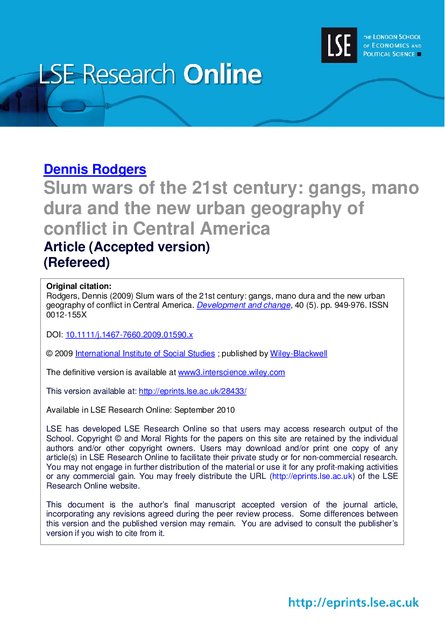
Abstract: The political economy of violence in Central America is widely perceived as having undergone a critical shift during the past two decades, often pithily summarised as a movement from ‘political’ to ‘social’ violence. Although such an analysis is plausible, it also offers a depoliticised vision of the contemporary Central American panorama of violence. Basing itself principally on the example of Nicaragua, the country in the region that is historically perhaps most paradigmatically associated with violence, this paper offers an alternative interpretation of the changes that the regional landscape of violence has undergone. It suggests that these are better understood as a movement from ‘peasant wars of the twentieth century’ (Wolf, 1969) to ‘urban wars of the twenty-first century’ (Beall, 2006), thereby highlighting how present-day urban violence can in fact in many ways be seen as representing a structural continuation of past political conflicts, albeit in new spatial contexts. At the same time, however, there are certain key differences between past and present violence, as a result of which contemporary conflict has intensified. This is most visible in relation to the changing forms of urban spatial organisation in Central American cities, the heavy-handed ‘Mano Dura’ response to gangs by governments, and the dystopian evolutionary trajectory of gangs. Taken together, these processes point to a critical shift in the balance of power between rich and poor in the region, as the new ‘urban wars of the twenty-first century’ are increasingly giving way to more circumscribed ‘slum wars’ that effectively signal the defeat of the poor, and concomitantly the end of the utopian dreams of revolution that the region is historically associated with.
Resource collections
- UN Habitat - Urban Response Collection
- Urban Response - Urban Crisis Preparedness and Risk Reduction
- Urban Response Collection - Community Engagement and Social Cohesion
- Urban Response Collection - Economic Recovery
- Urban Response Collection - Environment and Climate Change
- Urban Response Collection - Housing, Land and Property
- Urban Response Collection - Urban Crisis Response, Recovery and Reconstruction
- Urban Response Collection - Urban Resilience